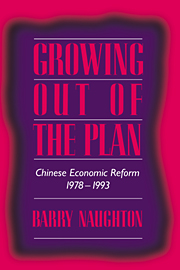Book contents
- Frontmatter
- Contents
- Tables and figures
- Preface
- Introductory
- Phase one The bird in the cage, 1979–1983
- 2 Crisis and response: Initial reorientation of the economy
- 3 State sector reforms, 1979–1983
- 4 Growth of the non-state sector
- Phase two Reforms take off, 1984–1988
- Phase three To a market economy
- Statistical appendix
- Notes
- Bibliography
- Index
2 - Crisis and response: Initial reorientation of the economy
Published online by Cambridge University Press: 03 May 2010
- Frontmatter
- Contents
- Tables and figures
- Preface
- Introductory
- Phase one The bird in the cage, 1979–1983
- 2 Crisis and response: Initial reorientation of the economy
- 3 State sector reforms, 1979–1983
- 4 Growth of the non-state sector
- Phase two Reforms take off, 1984–1988
- Phase three To a market economy
- Statistical appendix
- Notes
- Bibliography
- Index
Summary
By the late 1970s, Chinese leaders had been grappling with chronic economic problems for many years. Yet the decision to initiate a program of economic reform came remarkably suddenly. Within the span of a single year – between July 1978 and July 1979 – nearly every aspect of Chinese economic policy was recast. Major shifts in development strategy were accompanied by institutional changes that were quickly and vigorously implemented. Why did China move so rapidly to reverse its previous policy direction and move toward fundamental reform? The search for origins has an intrinsic interest, but it takes on additional significance in the Chinese case. Because reforms were begun without a clear reform objective, the initial measures determined the trajectory of reform and shaped the entire reform process. The origins of reform are thus inseparable from the story of how reforms managed to take hold and ultimately succeed.
In this chapter I argue that the driving force behind change in 1978–79 was a reorientation of Chinese development strategy. When one examines the entire spectrum of economic policies adopted between 1979 and 1981, one is struck above all by the vigor and consistency of the policies to reorient economic development strategy, rather than with the profundity of institutional reforms. The initial commitment to reform was, in a sense, a sideeffect of that reorientation and can only be fully understood in that context.
- Type
- Chapter
- Information
- Growing Out of the PlanChinese Economic Reform, 1978–1993, pp. 59 - 96Publisher: Cambridge University PressPrint publication year: 1995



